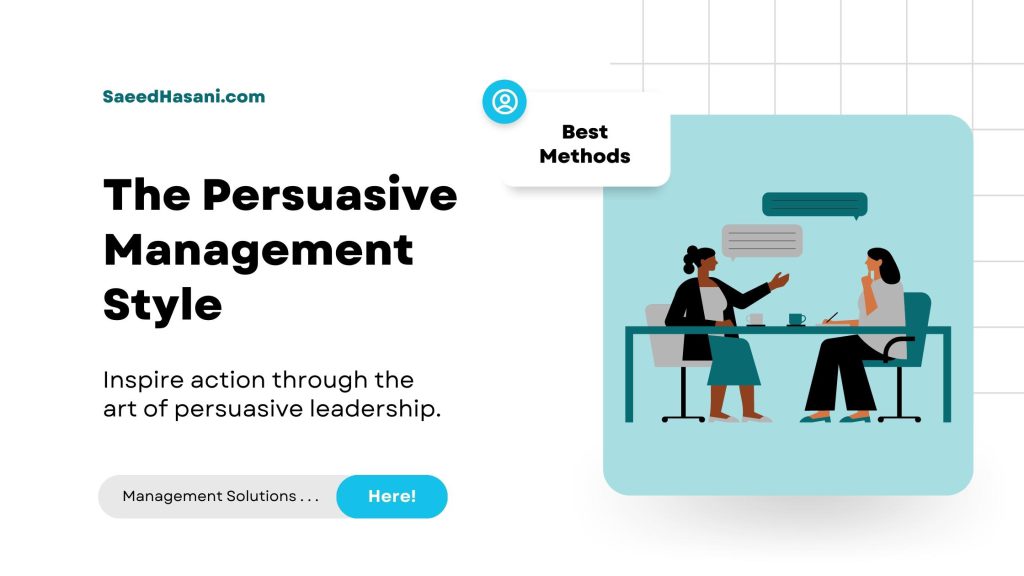The Persuasive management style | Motivating teams to succeed

When we look into the management world, we come across a powerful leadership approach known as the persuasive management style. This approach empowers managers and leaders to influence their teams. This approach in management can inspire and lead employees toward specific goals and desired results.
What is the Persuasive management style?
Persuasive management internally uses effective communication techniques and influencing strategies to gain unwavering support and commitment from employees.
A persuasive management style will be beneficial and effective in different situations:
For example, when introducing significant changes or promoting new ideas in an organization.
Also, managers use this management style to gain employee support for organizational strategies or to encourage effective employee participation.
Managers should be able to use persuasive and other leadership styles, depending on the specific situation and the people they lead.
What are the characteristics of a persuasive management style?
# Effective communication
Managers who use this style are more adept at communicating with their employees.
They express their ideas in a way that is clear to the employees. Also, the managers express their views concisely and convincingly so that the team members welcome these ideas.
# Building trust and credibility
Persuasive managers focus on building trust and credibility in their teams. Employees welcome managers’ ideas and suggestions when they trust their managers and recognize them as experts.
# Empathy and careful listening
They also listen well and engage with employees. They consider the opinions, needs, and concerns of their employees.
# Vision and inspiration
One characteristic of persuasive leaders is that they often present a clear and compelling vision for the future. So they paint an attractive picture of what can be achieved and inspire and motivate their team members to work towards common goals.
# Influence and negotiation
Persuasive managers know various influencing and negotiation techniques to persuade others. They use these techniques to support their ideas or initiatives.
# Fexibility
Persuasive managers are determined to achieve their goals. Of course, they are adaptable and welcome to hear feedback from others.
# Positive reinforcement
Persuasive managers reward the positive performance of their employees. In this way, work teams will have more motivation to do things.
# Ethical approach
Persuasion is a powerful tool, so managers must use it ethically and responsibly. Managers must understand that transparency is essential to maintaining trust and honesty.
How does a persuasive management style differ from other management styles?
The persuasive management style is known as a distinctive style in management science. This management style distinguishes itself from other leadership, communication, and motivation approaches. Here are the key differences between persuasive management and different management styles:
Persuasive management style compared to autocratic leadership
We all know autocratic managers who make unilateral decisions and exercise complete control without input from team members.
In contrast, persuasive managers actively seek to engage their teams. They use effective communication to get their employees to support their ideas.
Democratic management and persuasive management
Democratic managers ask their team members to participate in decisions and value their participation.
Persuasive managers also value employee participation in decision-making but have a clearer vision. Then they use persuasion to align the team with their goals.
Laissez-Faire management
Laissez-faire managers want team members to participate in decisions with considerable freedom and independence.
But persuasive managers use persuasion to align employees with the organization’s decisions and actively lead their teams toward specific goals.
Transformational management
Transformational managers have high expectations from their employees and seek to challenge the status quo. They inspire people and motivate their employees.
But persuasive managers try to focus by influencing and motivating employees through effective communication and negotiation to achieve specific goals.
Persuasive management and transactional management
The main emphasis of interactive managers is on rewards and punishments based on performance.
But persuasive managers sometimes use positive reinforcement, but their main focus in compelling communication is to create and strengthen commitment and support.
Servant leadership versus persuasive management
Servant leaders prioritize their team’s well-being and development to meet their needs.
But persuasive managers are driven by achieving specific results. They use persuasion to align team efforts with particular goals.
Coaching leadership
Coaching leaders seek to develop the skills and potential of their team members through mentoring.
But persuasive managers use persuasive techniques to motivate employees to work towards common goals.
Charismatic leadership versus persuasive leadership
Charismatic leaders are strong people whose behavior inspires and motivates their followers.
Convincing managers sometimes display charismatic qualities but generally rely on persuasive communication to gain support.
Bureaucratic management
Bureaucratic managers adhere strictly to rules and processes.
But persuasive managers are flexible and show their adaptability to do different things.
The persuasive management style emphasizes effective communication, influence, and motivation to achieve specific goals. Unlike other management styles, this style seeks to persuade teams instead of imposing decisions.
Adopting persuasive leadership can pave the way for success. Do you know how? This unique approach captivates teams, aligns efforts, and fosters a sense of unity in achieving common goals.
How can an ideal management style contribute to organizational success?
An ideal management style goes beyond mere supervision. This dynamic approach can set the stage for extraordinary success by creating a positive work environment and stimulating employee productivity and engagement.
The following will introduce fundamental ways the ideal management style causes significant organizational changes.
Effective communications
If goals, expectations, and changes are communicated to the team, misunderstandings are minimized, and employees are instilled with a unified sense of purpose.
Empowerment
The ideal management style strives to empower employees. When employees are free to make decisions, trust and innovation flourish in the organization.
Team building
A distinctive feature of the ideal management style is the promotion of teamwork and cooperation. Accommodating diverse perspectives and organizing team-building activities are essential to forming a high-performing team. This characteristic of idealist management is similar to the Persuasive management style.
Performance evaluation
Regular feedback and constructive criticism are essential and influential in guiding employee growth. An effective performance appraisal system fosters a culture of continuous improvement among employees. In this way, it leads people to progress.
Development of skills
Successful managers enhance the overall competence of the organization by nurturing and strengthening the skills of their team members. In general, they prepare employees for future challenges and opportunities.
Motivate employees
When team members feel appreciated for their contributions, they give more, and their commitment skyrockets. In this way, they perform their roles better. This characteristic of ideal management is similar to the Persuasive management style.
Conflict resolution skills
If the conflicts within the team are adequately resolved, coordination and cooperation among employees will occur. A successful manager wastes no time in addressing issues. He prevents productivity from being diverted due to conflicts. Learning conflict resolution skills helps maintain a cohesive work environment.
Vision and direction
A skilled manager sets a clear vision for the organization. He is determined to align the efforts of each employee toward common goals. This way, everyone works harmoniously to achieve the organization’s goals.
Adaptability
An ideal management style adapts itself to the changes and fluctuations of the market. Embracing flexibility enables organizations to respond quickly to challenges, seize new opportunities, and create a competitive advantage.
Staff welfare
A manager prioritizing employee well-being and work-life balance fosters a healthier, more engaged workforce. Paying attention to the well-being of employees reduces absenteeism and increases productivity.
Resource allocation
Effective managers strategically allocate resources and prioritize projects based on their potential impact on organizational success. In this way, this intelligent approach helps them use resources more efficiently and helps the organization progress.
Continuous improvement
If there is a culture of constant improvement in the organization, the ideal management style can be better developed by learning from successes and mistakes.
Remember that a perfect management style that supports employee empowerment, fosters effective communication, fosters skill development, and promotes teamwork can achieve organizational success.
By creating a positive, productive, and high-performance work environment, this approach becomes a driving force that drives the organization towards unprecedented success and unique achievements.
What are the key features of a democratic management style?
In the world of leadership, there is a management approach called democratic management style. The democratic management style emphasizes cooperation, empowerment, and inclusiveness.
Also known as participative management, this leadership philosophy involves employees in decision-making processes. In the following, we will introduce the main features of the democratic management style.
Employee participation
In this management approach, employees are actively encouraged to participate in decision-making. Their ideas, suggestions, and feedback are valuable.
Democratic management, involving employees in decision-making, gets to know different viewpoints. This approach has significant advantages, leading to better decisions and more innovative solutions. This feature can also be seen in the Persuasive management style.
Open communication
Clear and open communication is one of the main features of democratic management. In this management style, there are meetings with regular feedback and one-on-one interactions. In this way, employees are informed about organizational developments, and at the same time, their concerns and issues are addressed.
Trust and respect
Trust and respect are essential principles in democratic management. In this management style, managers trust the abilities of their employees and value their participation. In this way, employees also believe in their managers because they know that the manager listens to and pays attention to their opinions.
Empowerment
Democratic management instills a sense of ownership and autonomy in working with capable employees. Despite this empowerment, they assume responsibilities and can be decision-makers in their work area. In this management style, excessive control is avoided.
Flexibility and adaptability
This feature can also be seen in the Persuasive management style. When employees participate in decision-making in the work environment, the work environment becomes more flexible and adaptable. This agility makes people adapt faster to changes and challenges, making the organization more flexible.
Focus on continuous development and improvement of employees
Democratic managers prioritize the growth and development of their employees. They provide opportunities for learning, training, and upskilling their workforce so that they are motivated enough to get things done. Democratic management fosters a culture of continuous improvement.
Variety
In a democratic management environment, diversity is essential, and celebrate managers recognize and welcome their employees’ unique skills, experiences, and backgrounds in this management method. Managers understand how this diversity contributes to the overall success of the organization.
Long term vision
Democratic management style focuses on long-term vision and sustainable growth. For a democratic manager, employee welfare is essential because it increases employee loyalty.
In general, a democratic management style fosters a positive work culture so that employees feel valued and engaged. Employees at a favorable level regarding well-being, finances, and motivation will do their best for the organization’s success.
Employees in such an organization are creative and have a deep sense of ownership of their work, which leads to a strong and prosperous organization.
How does a laissez-faire management style function in a team setting?
The laissez-faire management style, the hands-off or non-directive approach, empowers teams to chart their course and make decisions independently. In this leadership method, managers provide minimal guidance, allowing team members to set goals and find innovative ways to achieve them. While its success varies depending on the team and project, understanding the dynamics of this style is essential for optimal performance.
Autonomy and Independence
Laissez-faire management fosters a sense of ownership among team members. Experienced and self-motivated individuals flourish in an environment where they can choose their methods and approaches.
Creativity and Innovation
Unencumbered by constant oversight, team members tap into their creativity, leading to dynamic and innovative problem-solving sessions where fresh ideas are celebrated.
Flexibility and Adaptability
This feature can also be seen in the Persuasive management style. Laissez-faire management allows teams to be agile, ideal for navigating complex and unpredictable projects without the constraints of rigid guidelines.
Time Management Challenges
The absence of strict direction can lead to time management issues. Some team members may need help prioritizing tasks and setting deadlines, affecting project timelines.
Team Dynamic
Success under laissez-faire management hinges on the team’s dynamics and the individual members’ capabilities. High-performing, self-motivated teams with solid communication skills are likely to thrive.
Risk of Inefficiency and Lack of Accountability
The absence of oversight may lead to decreased productivity and accountability. With clear expectations and monitoring, team members might feel more responsible for their actions.
Communication and Coordination
Effective communication becomes paramount in a laissez-faire setting. With minimal manager guidance, team members must collaborate efficiently to avoid misunderstandings and redundant efforts.
Leadership and Support
While managers maintain a hands-off approach, they remain available to offer support, guidance, and resources, ensuring the team stays on track.
Consequently, the effectiveness of the free management style in a team complex relies heavily on the nature of the project, the expertise of the team members, and the manager’s ability to strike the right balance between leadership and occasional support.
Assessing the team’s strengths and weaknesses and considering project demands are vital for adopting the appropriate management style. Embracing the freedom of laissez-faire can pave the way for an empowered and innovative team dynamic.
What is the managing style of leadership that focuses on employee empowerment?
In today’s dynamic business landscape, effective leadership does not just give orders and strive to maintain control. Empowering team members to flourish and achieve success is essential to him.
Empowering leadership, like the Persuasive management style, is a management style that focuses on empowering employees. By providing empowerment and support, this approach encourages people to take the initiative and actively contribute to the organization’s success. Critical characteristics of empowerment leadership:
Delegation of authority
Empowering leaders trust their team members, delegate tasks and responsibilities, and allow employees to take control of their work. Delegation fosters a more profound commitment to achieving shared goals.
The trust
At the heart of empowerment leadership lies trust. Leaders have faith in their employees’ abilities and judgment and trust their decision-making abilities. This mutual trust creates a positive work environment and encourages open communication.
Support and guidance
Employees are constantly exposed to ongoing support, guidance, and coaching to help employees grow and excel in their roles. This support system empowers people to overcome challenges and achieve personal and organizational goals. The persuasive management style also has this feature.
Autonomy for creativity
Employees are granted autonomy to make decisions in their areas of expertise. For this reason, this management style is similar to the Persuasive management style. This independence fuels creativity, innovation, and a sense of responsibility.
Skill development and growth
Empowering leaders invest in their employees’ growth by providing ample opportunities for skill development and learning. This focus on continuous improvement ensures a competent team.
Recognition and reward
Appreciating employee achievements is a critical aspect of empowerment leadership. Leaders provide recognition and appropriate rewards for outstanding contributions and encourage employees to strive for excellence.
Emphasis on open communication
Effective communication is the cornerstone of empowerment leadership. Leaders actively encourage open dialogue, listening to their team members’ ideas, concerns, and feedback.
Benefits of Empowerment Leadership
– Increasing employee participation
Empowered employees feel valued and appreciated, leading to higher engagement levels. Employee participation is meaningful both in this and the Persuasive management styles.
Improving job satisfaction
Empowerment leadership fosters a positive work culture where employees feel trusted and supported. That, in turn, increases job satisfaction and lowers turnover rates.
Higher productivity
Employees become more motivated and productive with autonomy and ownership of their work. Empowerment leadership causes efficiency and effectiveness in team performance. The persuasive management style also has this feature.
Advanced innovation
An empowered workforce is more likely to think creatively and develop innovative ideas. Leaders who encourage independent thinking and risk-taking create a culture of innovation in the organization.
Adopting empowering leadership, considered one of the management styles, is a powerful way to unlock the full potential of your team. You can foster a work environment that promotes creativity, productivity, and engagement by trusting, supporting, and empowering your employees.
The benefits of empowering leadership can be seen throughout the organization, driving success and fostering a strong sense of camaraderie among team members. Therefore, in addition to paying attention to the Persuasive management style, it also benefits from the benefits of empowering management style.
Conclusion
In the end, the persuasive management style is the key to motivating teams and leading them to success. This leadership style empowers employees and allows team members to take ownership, make decisions, and actively contribute to the organization’s goals.
Managers who adopt a persuasive management style demonstrate critical attributes such as effective communication, trust-building, empathy, vision, and recognition of accomplishments. They empower their team members through delegation, support, and autonomy, fostering a culture of creativity, innovation, and accountability.
Compared to other management styles, persuasive management is a distinctive approach that encourages employee participation in decision-making, values diverse perspectives, and promotes a positive work culture.
While each leadership style has strengths, the persuasive management style’s ability to inspire and influence teams sets it apart. Understanding the nuances of different management styles, including open, democratic, and other approaches, helps leaders adapt their strategies to specific situations and teams.
The persuasive management style can unleash your team’s potential, foster innovation, and lead to unprecedented success. By recognizing the strengths and weaknesses of each style, managers can adjust their approach to maximize the team’s potential and steer the organization toward long-term success.







Responses